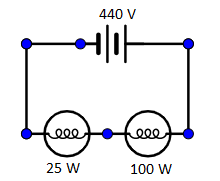
If two bulbs of $25\;{{W}}$ and $100\;{{W}}$ rated at $200\,V$ are connected in $440\,V$ supply, then
(A) $100$ watt bulb will fuse
(B) $25$ watt bulb will fuse
(C) none of the bulb will fuse
(D) both the bulbs will fuse
Answer
216.6k+ views
Hint: The resistance of each bulb will be different hence they have different powers. The voltage across each bulb has to be found using the resistance. Then the result will be compared to the voltage rating of the bulbs. By using the formula of the power, then the solution will be determined.
Complete step by step solution:
Given two bulbs having power, ${P_1} = 25\;{{W}}$ and ${P_2} = 100\;{{W}}$both are rated at voltage, $V = 200\;{{volts}}$ and connected in series with $440$ volts supply.

The expression for power is given as,
$P = \dfrac{{{V^2}}}{R}$
Where, $V$ is the voltage and $R$ is the resistance.
From the above expression,
$R = \dfrac{{{V^2}}}{P}$
Hence, we can find the resistance of each bulb using this equation for the given power and voltage rating.
$ \Rightarrow {R_1} = \dfrac{{{V^2}}}{{{P_1}}} \\
\Rightarrow \dfrac{{{{\left( {200\;{{V}}} \right)}^2}}}{{25\;{{W}}}} \\
\Rightarrow 1600\;\Omega$
The resistance of $25\;{{W}}$ bulb is $1600\;\Omega $.
And,
$\Rightarrow {R_2} = \dfrac{{{V^2}}}{{{P_2}}} \\
\Rightarrow \dfrac{{{{\left( {200\;{{V}}} \right)}^2}}}{{100\;{{W}}}} \\
\Rightarrow 400\;\Omega$
The resistance of $100\;{{W}}$ is $400\;\Omega $.
Since the two bulbs are connected in series, the total resistance will be ${R_1} + {R_2}$.
The voltage across each bulb will be different. They are connected to $440$ volts supply also.
Hence, the voltage across the $25\;{{W}}$ bulb is given as,
$\Rightarrow {V_1} = 440\;{{V}} \times \dfrac{{{R_1}}}{{{R_1} + {R_2}}}$
Substituting the values in the above expression,
$\Rightarrow {V_1} = 440\;{{V}} \times \dfrac{{1600\;\Omega }}{{1600\;\Omega + 400\;\Omega }} \\
\Rightarrow 352\;{{V}}$
The voltage across $25\;{{W}}$ is $352\;{{V}}$. This is higher than the rated voltage $200\;{{volts}}$. Therefore, the bulb will fuse.
The voltage across $100\;{{W}}$ bulb is given as,
$\Rightarrow {V_2} = 440\;{{V}} \times \dfrac{{{R_2}}}{{{R_1} + {R_2}}}$
Substituting the values in the above expression,
$\Rightarrow {V_2} = 440\;{{V}} \times \dfrac{{400\;\Omega }}{{1600\;\Omega + 400\;\Omega }} \\
\Rightarrow 88\;{{V}} $
The voltage across $100\;{{W}}$ is $88\;{{V}}$. This is lower than the rated voltage $200\;{{volts}}$. Therefore, the bulb will not fuse.
Therefore, only the $25\;{{W}}$ bulb will fuse.
The answer is option B.
Note: If two bulbs have the same voltage rating but the power is different, then a bulb having high power will have low resistance. And the low power bulb will fuse than the high power bulb. The power is directly proportional to the square of the voltage and inversely proportional to the resistance.
Complete step by step solution:
Given two bulbs having power, ${P_1} = 25\;{{W}}$ and ${P_2} = 100\;{{W}}$both are rated at voltage, $V = 200\;{{volts}}$ and connected in series with $440$ volts supply.

The expression for power is given as,
$P = \dfrac{{{V^2}}}{R}$
Where, $V$ is the voltage and $R$ is the resistance.
From the above expression,
$R = \dfrac{{{V^2}}}{P}$
Hence, we can find the resistance of each bulb using this equation for the given power and voltage rating.
$ \Rightarrow {R_1} = \dfrac{{{V^2}}}{{{P_1}}} \\
\Rightarrow \dfrac{{{{\left( {200\;{{V}}} \right)}^2}}}{{25\;{{W}}}} \\
\Rightarrow 1600\;\Omega$
The resistance of $25\;{{W}}$ bulb is $1600\;\Omega $.
And,
$\Rightarrow {R_2} = \dfrac{{{V^2}}}{{{P_2}}} \\
\Rightarrow \dfrac{{{{\left( {200\;{{V}}} \right)}^2}}}{{100\;{{W}}}} \\
\Rightarrow 400\;\Omega$
The resistance of $100\;{{W}}$ is $400\;\Omega $.
Since the two bulbs are connected in series, the total resistance will be ${R_1} + {R_2}$.
The voltage across each bulb will be different. They are connected to $440$ volts supply also.
Hence, the voltage across the $25\;{{W}}$ bulb is given as,
$\Rightarrow {V_1} = 440\;{{V}} \times \dfrac{{{R_1}}}{{{R_1} + {R_2}}}$
Substituting the values in the above expression,
$\Rightarrow {V_1} = 440\;{{V}} \times \dfrac{{1600\;\Omega }}{{1600\;\Omega + 400\;\Omega }} \\
\Rightarrow 352\;{{V}}$
The voltage across $25\;{{W}}$ is $352\;{{V}}$. This is higher than the rated voltage $200\;{{volts}}$. Therefore, the bulb will fuse.
The voltage across $100\;{{W}}$ bulb is given as,
$\Rightarrow {V_2} = 440\;{{V}} \times \dfrac{{{R_2}}}{{{R_1} + {R_2}}}$
Substituting the values in the above expression,
$\Rightarrow {V_2} = 440\;{{V}} \times \dfrac{{400\;\Omega }}{{1600\;\Omega + 400\;\Omega }} \\
\Rightarrow 88\;{{V}} $
The voltage across $100\;{{W}}$ is $88\;{{V}}$. This is lower than the rated voltage $200\;{{volts}}$. Therefore, the bulb will not fuse.
Therefore, only the $25\;{{W}}$ bulb will fuse.
The answer is option B.
Note: If two bulbs have the same voltage rating but the power is different, then a bulb having high power will have low resistance. And the low power bulb will fuse than the high power bulb. The power is directly proportional to the square of the voltage and inversely proportional to the resistance.
Recently Updated Pages
Wheatstone Bridge Explained: Working, Formula & Uses

Young’s Double Slit Experiment Derivation Explained

JEE Atomic Structure and Chemical Bonding important Concepts and Tips

JEE Amino Acids and Peptides Important Concepts and Tips for Exam Preparation

Electricity and Magnetism Explained: Key Concepts & Applications

Chemical Properties of Hydrogen - Important Concepts for JEE Exam Preparation

Trending doubts
JEE Main 2026: Application Form Open, Exam Dates, Syllabus, Eligibility & Question Papers

Derivation of Equation of Trajectory Explained for Students

Hybridisation in Chemistry – Concept, Types & Applications

Understanding the Angle of Deviation in a Prism

Understanding Collisions: Types and Examples for Students

How to Convert a Galvanometer into an Ammeter or Voltmeter

Other Pages
JEE Advanced Marks vs Ranks 2025: Understanding Category-wise Qualifying Marks and Previous Year Cut-offs

Understanding Atomic Structure for Beginners

Ideal and Non-Ideal Solutions Explained for Class 12 Chemistry

Degree of Dissociation: Meaning, Formula, Calculation & Uses

Understanding Electromagnetic Waves and Their Importance

Understanding the Electric Field of a Uniformly Charged Ring




